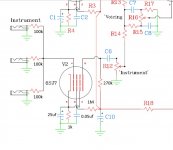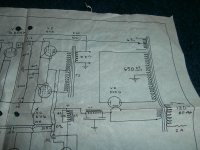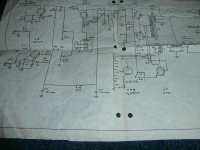Hello,
I recently rebuilt a 1954 Gibson GA40. The wiring was in bad shape and lots of parts had been previous replaced, mix of old and new, the rats nest made it very difficult to troubleshoot. I rebuilt the entire circuit using a tag board, fired it up, everything is working well and I believe the voltages to be in spec with other GA40 users.
However - there is considerable hum being generated by both V1/V2 6SJ7 input stages when the volumes are turned up loud. When I ground the input grids (pin 4) the circuit goes silent, so I know the source of this hum. Is this a natural characteristic of this input tube at this level of gain? Pin 1 (shield) is grounded and I've subbed in many different tubes (both glass and metal envelope. They all seem to be the same and have moderate mmicrophonic levels. I've used shielded wiring and dressed the heaters properly.
I've attached the input stage schematic. Voltages are as follows:
HV supply: 212v
Plate: 35v
Screen: 22v
Cathode: 1v
Anything seem unusual? Any tips to quiet it down?
I recently rebuilt a 1954 Gibson GA40. The wiring was in bad shape and lots of parts had been previous replaced, mix of old and new, the rats nest made it very difficult to troubleshoot. I rebuilt the entire circuit using a tag board, fired it up, everything is working well and I believe the voltages to be in spec with other GA40 users.
However - there is considerable hum being generated by both V1/V2 6SJ7 input stages when the volumes are turned up loud. When I ground the input grids (pin 4) the circuit goes silent, so I know the source of this hum. Is this a natural characteristic of this input tube at this level of gain? Pin 1 (shield) is grounded and I've subbed in many different tubes (both glass and metal envelope. They all seem to be the same and have moderate mmicrophonic levels. I've used shielded wiring and dressed the heaters properly.
I've attached the input stage schematic. Voltages are as follows:
HV supply: 212v
Plate: 35v
Screen: 22v
Cathode: 1v
Anything seem unusual? Any tips to quiet it down?
Attachments
So grounding the grid pin kills the hum. But the shorting jacks do not kill the hum?
The difference is the 100K, and whatever stray hum field is around their junction and the grid pin.
Do you really need 3 inputs today?
The difference is the 100K, and whatever stray hum field is around their junction and the grid pin.
Do you really need 3 inputs today?
I don't know if that's your schematic or you found it somewhere, but it looks like it is based on the hand drawn (chicken scratch) schematic floating around the web, that definitely does not come from Gibson.
In any case, I really doubt Gibson omitted a grid leak resistor. The GA40 Les Paul model amp schematic shows a 1 M grid leak on the input grid, that's more realistic.
In any case, I really doubt Gibson omitted a grid leak resistor. The GA40 Les Paul model amp schematic shows a 1 M grid leak on the input grid, that's more realistic.
Hey guys, thanks for jumping on board.
I've already tried removing two of the instrument inputs from the circuit however it made no appreciable difference.
I built this amp using Jack Hester's schematic which he made by tracing two separate GA40's, comparisons with a few other amp owners, plus an old paper schematic (which I may have also found, it was for sale on reverb so I just did a few screen-grabs). I'll include both as attachments.
I've already tried removing two of the instrument inputs from the circuit however it made no appreciable difference.
I built this amp using Jack Hester's schematic which he made by tracing two separate GA40's, comparisons with a few other amp owners, plus an old paper schematic (which I may have also found, it was for sale on reverb so I just did a few screen-grabs). I'll include both as attachments.
Attachments
This plan, in context, does not need a grid to ground resistor.
Before pedals, or active boosters, we only had naked guitars and they always conduct DC quite well. 5K if no-knob or dimed, 250K for worst-case volume connection and setting.
Further there are 3 inputs and unused inputs are shorted to ground through 100K mix resistors. If only one player uses the amp there is 50K leakage. If three use the same amp, surely one will have a DC path through the guitar.
Yes, today we would throw the 13 cents for a resistor to be sure it won't crap-out with three active cap-coupled un-leaky sources.
Before pedals, or active boosters, we only had naked guitars and they always conduct DC quite well. 5K if no-knob or dimed, 250K for worst-case volume connection and setting.
Further there are 3 inputs and unused inputs are shorted to ground through 100K mix resistors. If only one player uses the amp there is 50K leakage. If three use the same amp, surely one will have a DC path through the guitar.
Yes, today we would throw the 13 cents for a resistor to be sure it won't crap-out with three active cap-coupled un-leaky sources.
In post #4, the ratio R29 R19 looks dubious, and is very different from picture to PDF. 470 Ohms? 470K?
470 Ohms to 1K, that amp may squeal, but won't hum because it hardly amplifies.
470K to 1K is pointless; not enough internal gain to support NFB limit of 470.
I know Gibson docs are all dubious but.....
470 Ohms to 1K, that amp may squeal, but won't hum because it hardly amplifies.
470K to 1K is pointless; not enough internal gain to support NFB limit of 470.
I know Gibson docs are all dubious but.....
- Status
- Not open for further replies.
- Home
- Live Sound
- Instruments and Amps
- 6SJ7 noise



